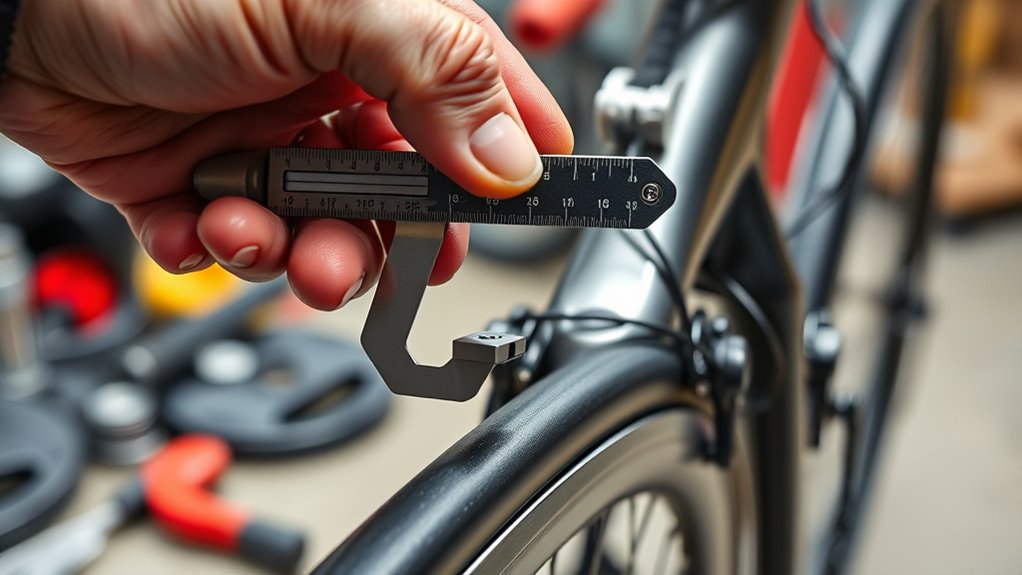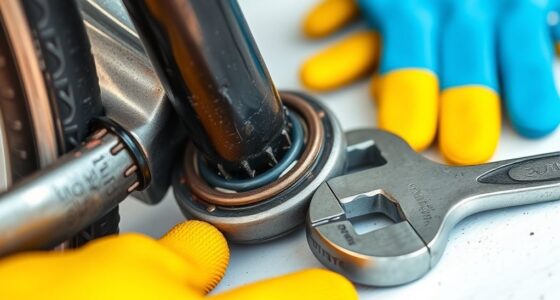To align a bent derailleur hanger, start by removing the wheel and attaching a derailleur hanger alignment tool to the hub or dropout. Spin the wheel slowly and observe any misalignment using the tool. Gently bend the hanger back into proper position, making small adjustments and frequently checking alignment. Once aligned, check the shifting by test riding or manually shifting gears. For detailed steps and tips, keep going to learn more about precise correction techniques.
Key Takeaways
- Attach a derailleur hanger alignment tool to the wheel hub or dropout to assess misalignment.
- Spin the wheel slowly and observe the indicator to identify the extent of bend or misalignment.
- Gently bend the hanger back into proper alignment using the alignment tool as a guide.
- Make small, incremental adjustments, checking frequently to avoid overcorrection.
- Reinstall the wheel, spin to verify, and test shifting to ensure smooth, accurate derailleur operation.

A bent derailleur hanger can cause poor shifting and chain skips, but fixing it is often a straightforward process. Before you get started, you’ll want to gather the right tools needed for the job. Typically, you’ll need a derailleur hanger alignment tool, which is designed specifically to check and straighten the hanger. Some cyclists also use a hex wrench or Allen key compatible with your bike’s derailleur hanger bolt. A small adjustable wrench or pliers might come in handy for removing and reinstalling components. A clean rag or cloth can help keep the area free of dirt and debris during the process. With the right tools in hand, you’re ready to diagnose and correct the problem.
Understanding common causes of bent derailleur hangers can help you prevent future issues. Hangers often bend from impacts—like hitting a curb, dropping the bike, or a crash. Sometimes, they bend gradually over time due to rough riding or chain tension. Improper wheel installation or removal can also lead to misalignment, as can shifting under heavy load or during aggressive riding. If your derailleur is hitting the spokes or the chain isn’t shifting smoothly, chances are the hanger is bent. Recognizing these common causes allows you to be more cautious and avoid damage in the future.
Bent derailleur hangers often result from impacts, rough riding, or improper wheel handling. Stay cautious to prevent misalignment.
Once you’ve identified that the hanger is bent, the next step is to check its alignment. Attach the derailleur hanger alignment tool to your wheel’s hub or dropout, following the manufacturer’s instructions. Spin the wheel slowly and observe the alignment of the tool’s indicator against the hanger. If it’s out of true—meaning the indicator shows misalignment—you’ll need to straighten the hanger. Carefully adjust the hanger by gently bending it back into proper position, using the alignment tool as your guide. You want to make small, incremental adjustments, checking frequently to avoid overcorrecting. The goal is to bring the hanger into perfect alignment with the wheel and derailleur.
After aligning the hanger, double-check your work by spinning the wheel and testing the shifting. The derailleur should now move smoothly across the gears without skipping or rubbing. If it still doesn’t shift correctly, re-examine the alignment and make fine adjustments. Regularly inspecting your derailleur hanger and keeping it straight can save you from more complex repairs later. Proper alignment ensures your bike shifts quietly and efficiently, giving you a smoother ride every time. Remember, a little patience and attention to detail go a long way in keeping your bike in top shape.
Frequently Asked Questions
How Often Should I Check My Derailleur Hanger Alignment?
You should check your derailleur hanger alignment every few months or after any bike storage or hiking maintenance. Regular checks prevent shifting issues and potential damage. If you hit a big bump or fall during hiking, inspect the hanger before your next ride. Proper alignment guarantees smooth gear changes and prolongs your bike’s lifespan. Make it part of your routine bike maintenance to keep your ride running flawlessly.
Can I Fix a Bent Hanger Without Tools?
You can’t fix a bent hanger properly without tools, as DIY repairs require specific tools like a derailleur hanger alignment tool or a small adjustable wrench. Attempting to bend it back with your hands or makeshift tools could cause more damage. To guarantee a proper fix and avoid further issues, it’s best to use the right tools or visit a bike shop. Proper alignment guarantees smooth shifting and safe riding.
What Signs Indicate a Misaligned Derailleur Hanger?
Did you know that about 60% of shifting issues stem from derailleur hanger misalignment? Signs include difficulty shifting gears, frequent gear slipping, or noisy operation. If you notice frame damage or your gears don’t stay in position, your hanger might be bent. Check for uneven spacing between the derailleur and cassette, and if you see these signs, it’s time to realign or replace the hanger for smooth rides.
Is It Safe to Ride With a Slightly Bent Hanger?
You shouldn’t ride with a slightly bent hanger because it can cause hanger damage and compromise ride safety. Even a small bend may lead to poor shifting, chain drop, or additional damage over time. It’s best to inspect the hanger carefully and realign or replace it if needed. Riding with a misaligned hanger risks further damage to your derailleur and drivetrain, so prioritize fixing it before hitting the road again.
How Much Does Professional Hanger Alignment Cost?
You might be surprised, but professional hanger alignment usually costs between $20 and $50. When you seek hanging repair, a professional service guarantees precision, preventing future issues. Coincidentally, many bike shops offer this service alongside other maintenance tasks. Investing in expert alignment saves you money and frustration later, keeping your bike shifting smoothly. Don’t overlook this quick, affordable fix — it’s worth it for a safer, more enjoyable ride.
Conclusion
Aligning a bent derailleur hanger is like straightening a crooked picture frame; it brings your bike’s performance back into focus. When you take the time to carefully realign, you’re restoring harmony between your gears and wheel, ensuring smooth rides ahead. Don’t rush the process—think of it as tuning a fine instrument. With patience and precision, you’ll keep your bike running true, turning every ride into a perfectly composed symphony of motion.









